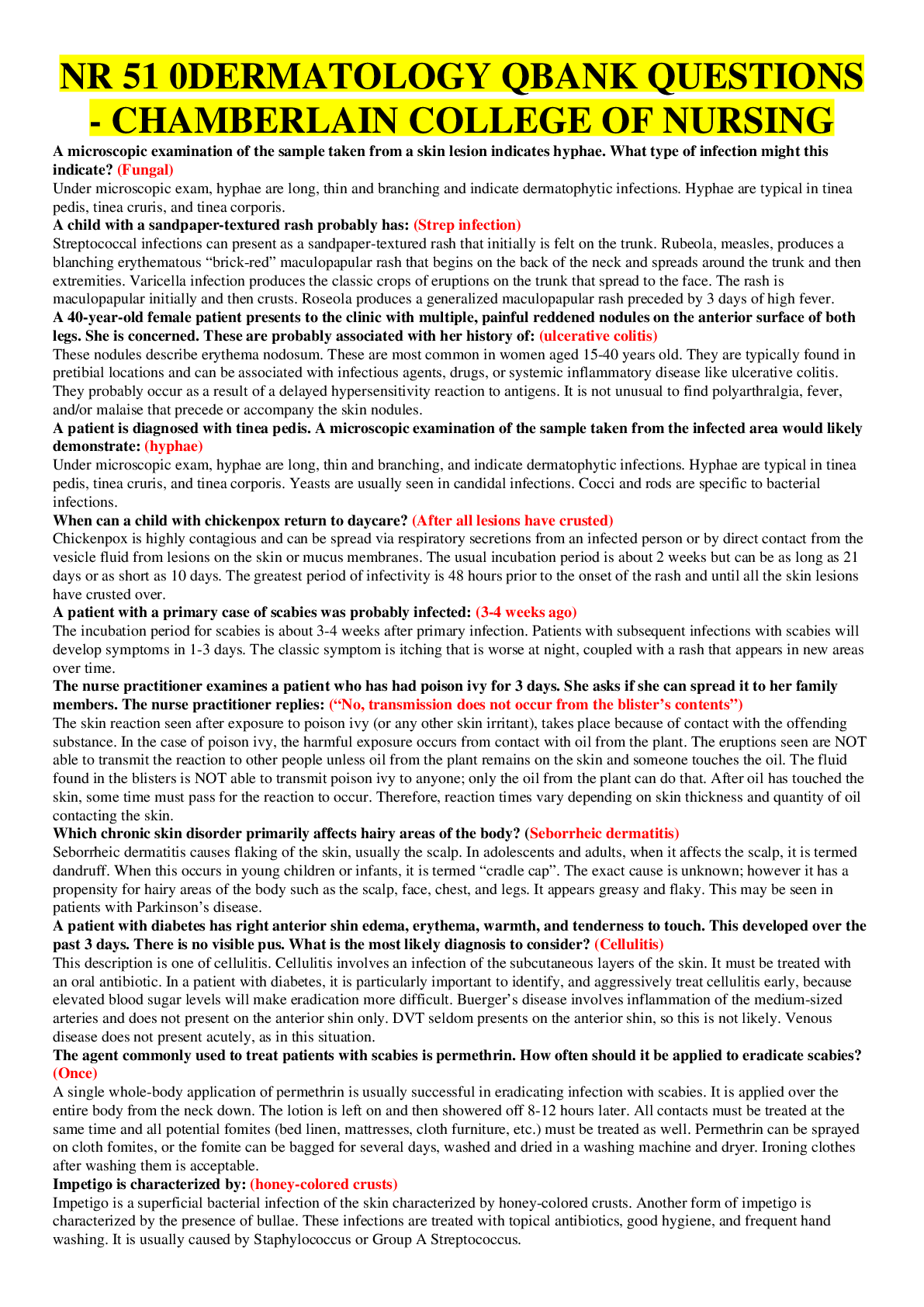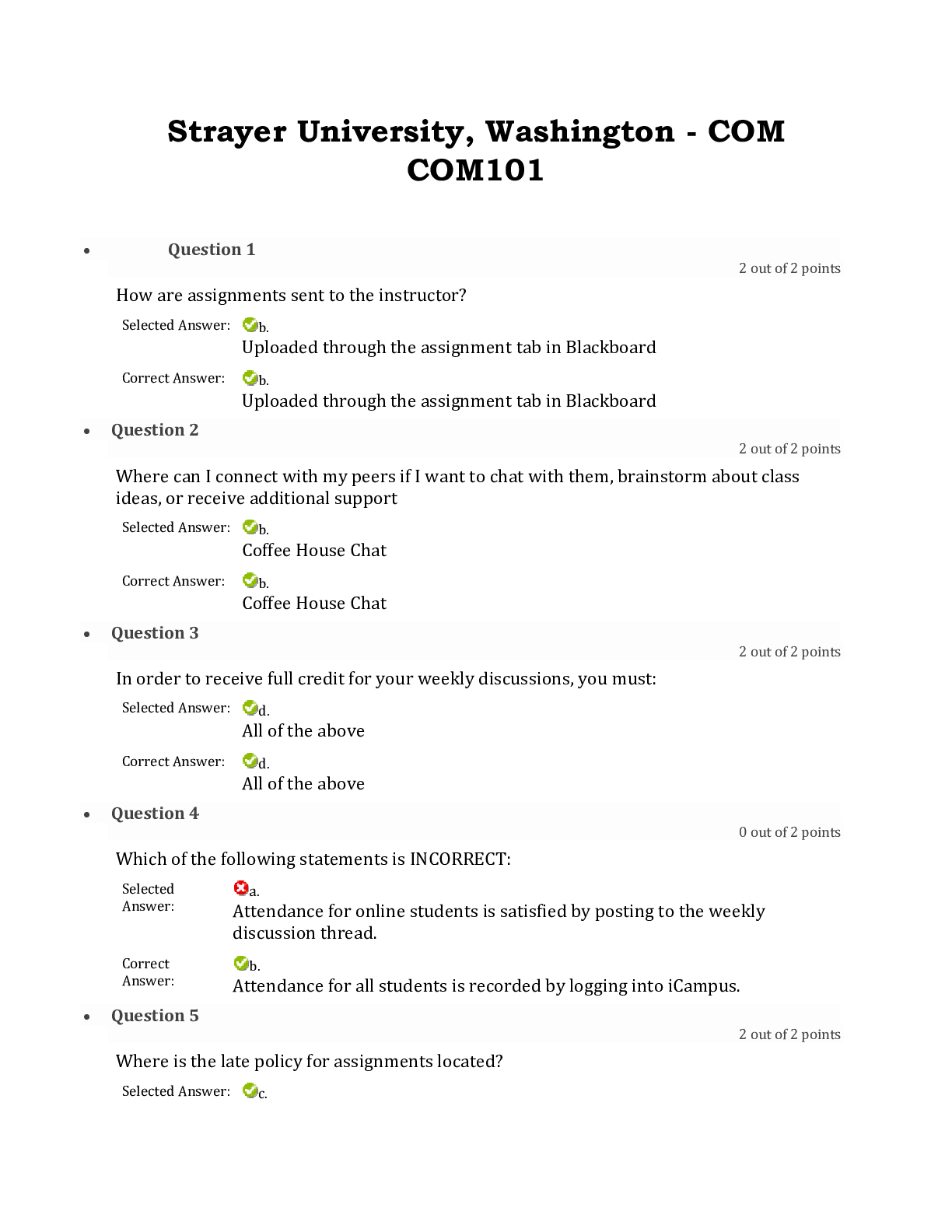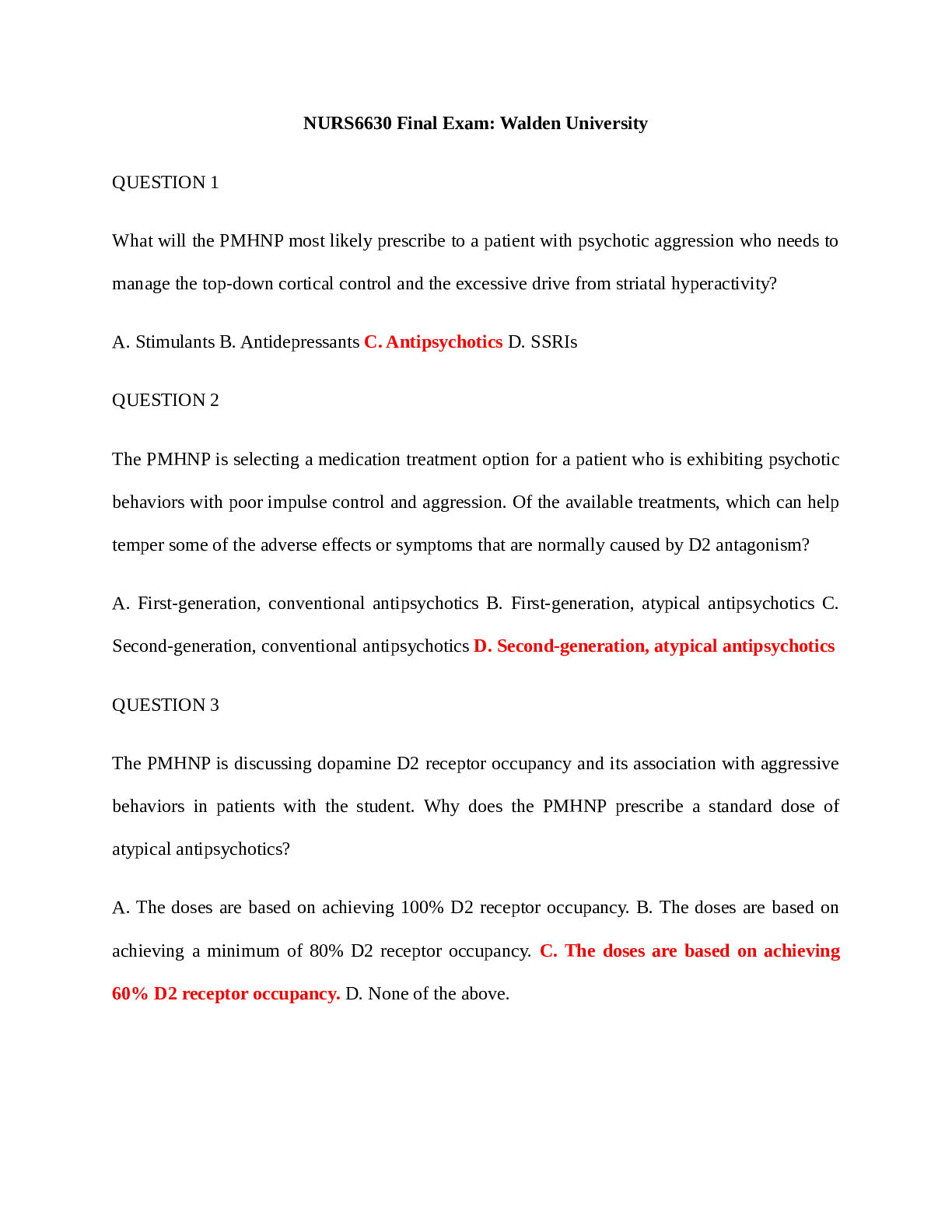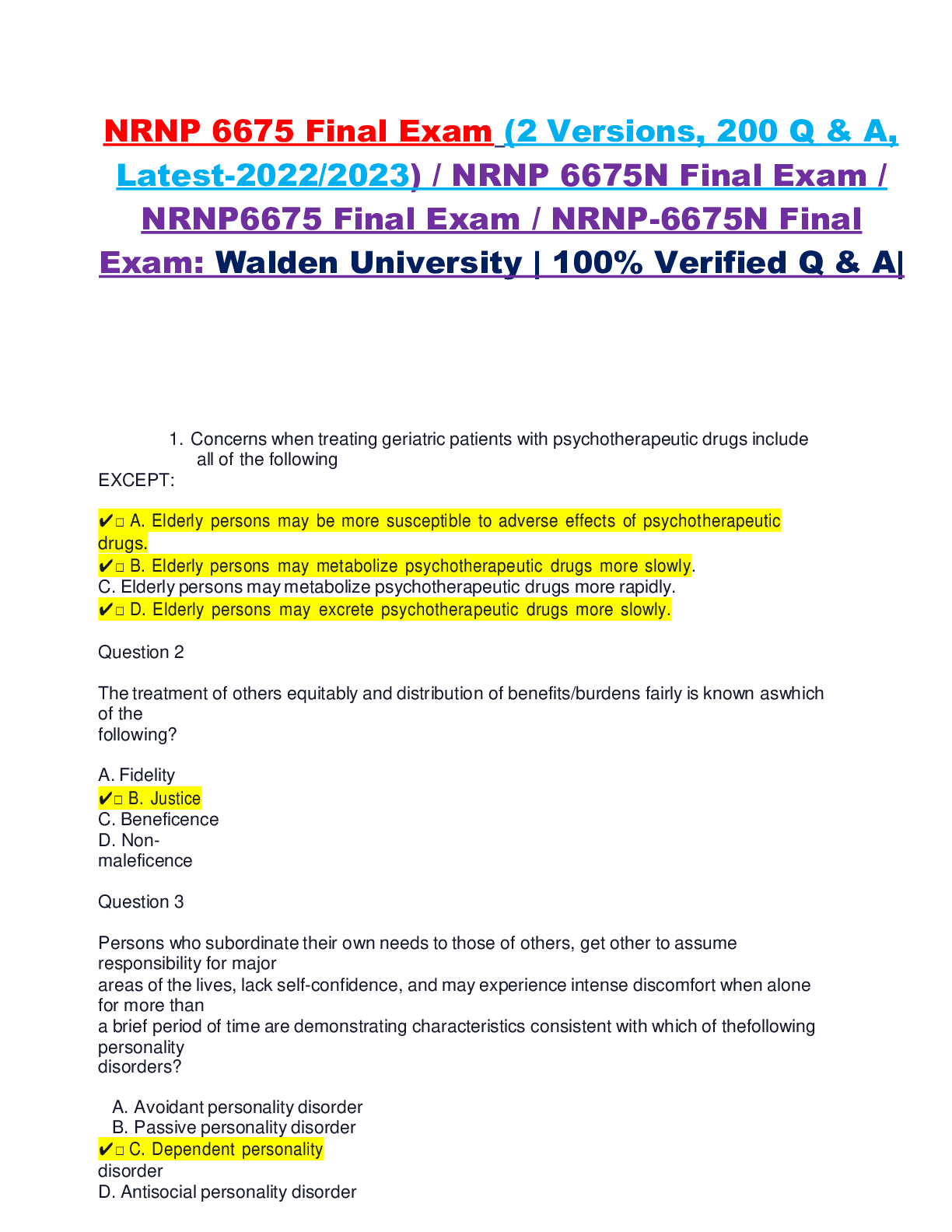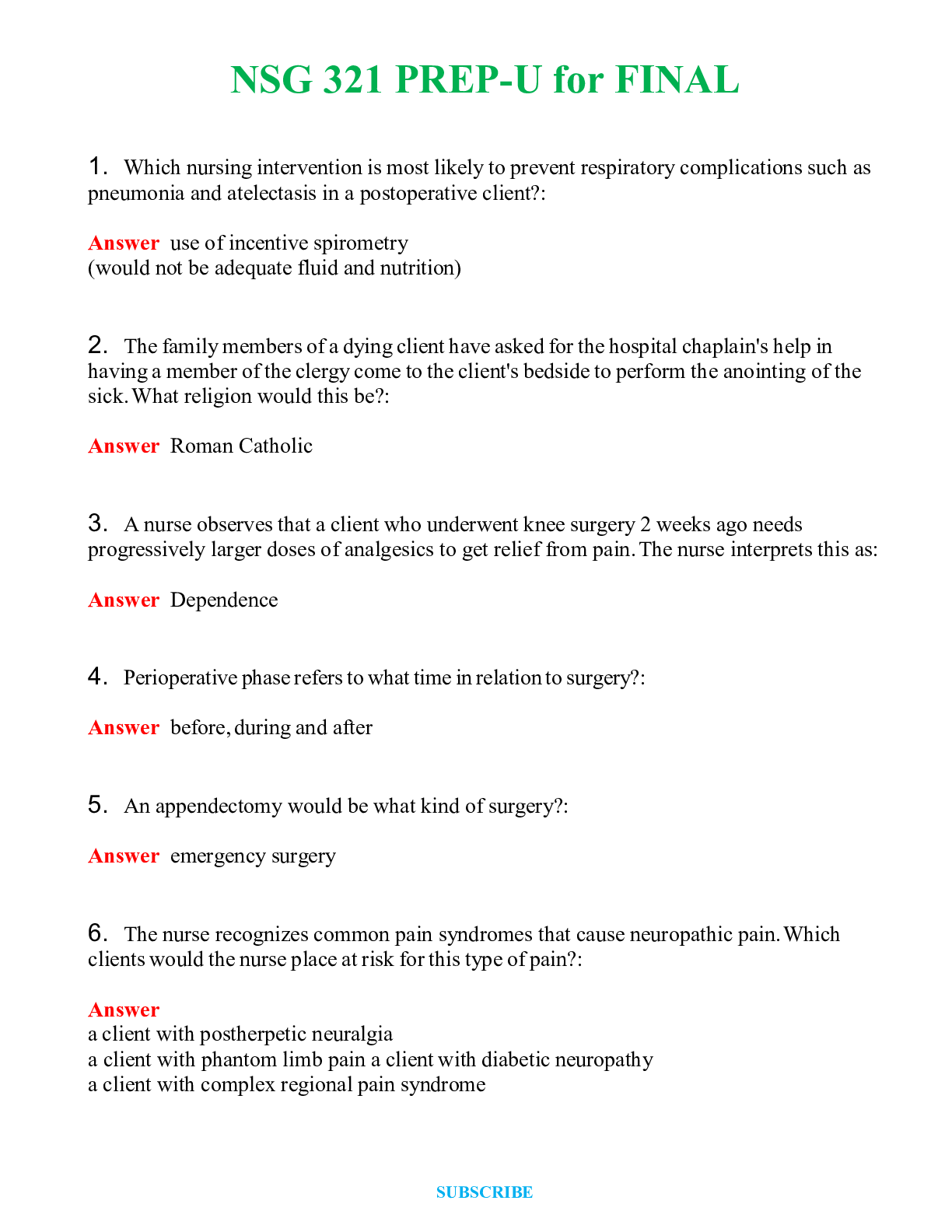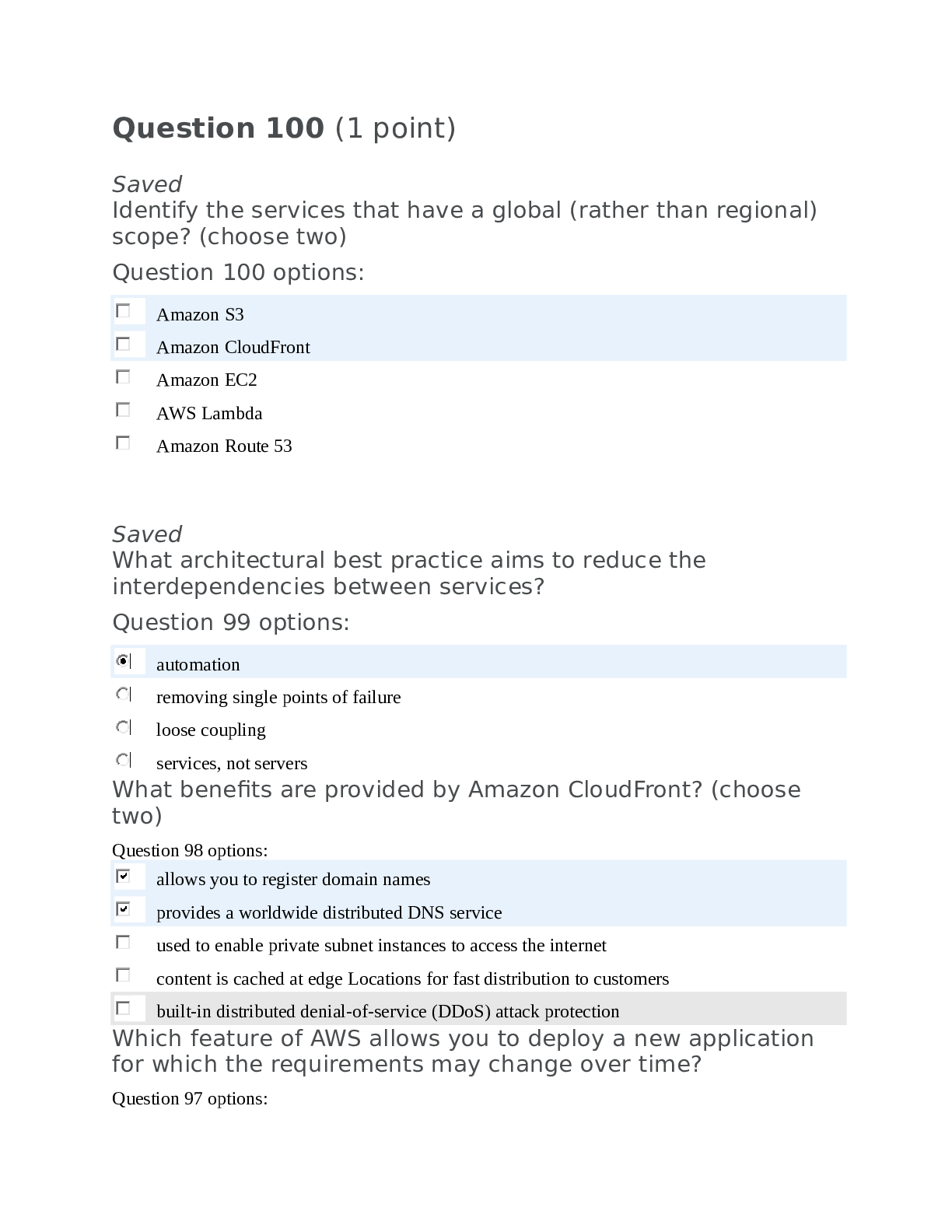NURS-6630N Final Exam
Document Content and Description Below
NURS-6630N Final Exam NURS-6630N Final Exam Mrs. Rosen is a 49-year-old patient who is experiencing fibro-fog. What does the PMHNP prescribe for Mrs. Rosen to improve this condition? Selected Ans... wer: D. All of the above An elderly woman with a history of Alzheimer’s disease, coronary artery disease, and myocardial infarction had a fall at home 3 months ago that resulted in her receiving an open reduction internal fixation. While assessing this patient, the PMHNP is made aware that the patient continues to experience mild to moderate pain. What is the PMHNP most likely to do? Selected Answer: A. Order an X-ray because it is possible that she dislocated her hip. The PMHNP is caring for a patient who reports excessive arousal at nighttime. What could the PMHNP use for a time-limited duration to shift the patient’s brain from a hyperactive state to a sleep state? Selected Answer: B. Benzodiazepi • Question 3 1 out of 1 points • Question 2 0 out of 1 points • Question 1 1 out of 1 points• Question 4 1 out of 1 points nes A patient addicted to heroin is receiving treatment for detoxification. He begins to experience tachycardia, tremors, and diaphoresis. What medication will the PMHNP prescribe for this patient? Selected Answer: D. Clonidine (Catapres) The PMHNP prescribes gabapentin (Neurontin) for a patient’s chronic pain. How does the PMHNP anticipate the drug to work? Selected Answer: A. It will bind to the alpha-2-delta ligand subunit of voltage-sensitive calcium channels. A patient with hypersexual disorder is being assessed for possible pharmacologic treatment. Why does the PMHNP prescribe an antiandrogen for this patient? Selected Answer: C. It will block testosterone. Which statement best describes a pharmacological approach to treating patients for impulsive aggression? Selected Answer: D. Opioid antagonists can be used to reduce drive. • Question 7 1 out of 1 points • Question 6 1 out of 1 points • Question 5 1 out of 1 pointsA 26-year-old female patient with nicotine dependence and a history of anxiety presents with symptoms of attention deficit hyperactivity disorder (ADHD). Based on the assessment, what does the PMHNP consider? Selected Answer: A. ADHD is often not the focus of treatment in adults with comorbid conditions. A patient with irritable bowel syndrome reports chronic stomach pain. The PMHNP wants to prescribe the patient an agent that will cause irrelevant nociceptive inputs from the pain to be ignored and no longer perceived as painful. Which drug will the PMHNP prescribe? Selected Answer: C. Duloxetine (Cymbalta) Parents of a 12-year-old boy want to consider attention deficit hyperactivity disorder (ADHD) medication for their son. Which medication would the PMHNP start? Selected Answer: All of the above could potentially treat their son’s symptoms. Which of the following is a true statement regarding the use of stimulants to treat attention deficit hyperactivity disorder (ADHD)? Selected Answer: B. Signal strength output is increased by dialing up the release of dopamine (DA) and norepinephrine (NE). Mr. Peterson is meeting with the PMHNP to discuss healthier dietary habits. With a BMI of • Question 12 1 out of 1 points • Question 11 1 out of 1 points • Question 10 1 out of 1 points • Question 9 1 out of 1 points • Question 8 1 out of 1 points33, Mr. Peterson is obese and needs to modify his food intake. “Sometimes I think I’m addicted to food the way some people are addicted to drugs,” he says. Which statement best describes the neurobiological parallels between food and drug addiction? Selected Answer: A. There is decreased activation of the prefrontal cortex. A 72-year-old male patient is in the early stages of Alzheimer’s disease. The PMHNP determines that improving memory is a key consideration in selecting a medication. Which of the following would be an appropriate choice? Selected Answer: D. All of the above A patient is prescribed D-methylphenidate, 10-mg extended-release capsules. What should the PMHNP include when discussing the side effects with the patient? Selected Answer: C. The medication can affect your blood pressure. The parents of a 7-year-old patient with ADHD are concerned about the effects of stimulants on their child. The parents prefer to start pharmacological treatment with a non-stimulant. Which medication will the PMHNP will most likely prescribe? Selected Answer: A. Stratt era The PMHNP is assessing a patient who has expressed suicidal intent and is now stating that he is hearing voices and sees people chasing him. The PMHNP identifies these symptoms to be associated with which of the following? • Question 16 1 out of 1 points • Question 15 1 out of 1 points • Question 14 1 out of 1 points • Question 13 1 out of 1 pointsSelected Answer: C. “Bath salt” intoxication An 80-year-old female patient diagnosed with Stage II Alzheimer’s has a history of irritable bowel syndrome. Which cholinergic drug may be the best choice for treatment given the patient’s gastrointestinal problems? Selected Answer: A. Donepezil (Aricept) A 63-year-old patient presents with the following symptoms. The PMHNP determines which set of symptoms warrant prescribing a medication? Select the answer that is matched with an appropriate treatment. Selected Answer: B. Impairment in the ability to learn and retain new information is most problematic, and an appropriate treatment option would be donepezil. The PMHNP is caring for a patient with chronic insomnia who is worried about pharmacological treatment because the patient does not want to experience dependence. Which pharmacological treatment approach will the PMHNP likely select for this patient for a limited duration, while searching and correcting the underlying pathology associated with the insomnia? Selected Answer: D. Non-benzodiazepine hypnotics The PMHNP is performing a quality assurance peer review of the chart of another PMHNP. Upon review, the PMHNP reviews the chart of an older adult patient in long-term care facility who has chronic insomnia. The chart indicates that the patient has been receiving hypnotics on a nightly basis. What does the PMHNP find problematic about this documentation? • Question 20 1 out of 1 points • Question 19 1 out of 1 points • Question 18 1 out of 1 points • Question 17 1 out of 1 pointsSelected Answer: B. Hypnotics have prolonged half-lives that can cause drug accumulation in the elderly. The PMHNP is evaluating a 30-year-old female patient who states that she notices pain and a drastic change in mood before the start of her menstrual cycle. The patient states that she has tried diet and lifestyle changes but nothing has worked. What will the PMHNP most likely do? Selected Answer: C. Prescribe desvenlafaxine (Pristiq), 50 mg daily The PMHNP is caring for a patient with fibromyalgia. Which second-line treatment does the PMHNP select that may be effective for managing this patient’s pain? Selected Answer: C. Imipramine (Tofranil) The PMHNP is assessing a patient she has been treating with the diagnosis of chronic pain. During the assessment, the patient states that he has recently been having trouble getting to sleep and staying asleep. Based on this information, what action is the PMHNP most likely to take? Selected Answer: A. Order hydroxyzine (Vistaril), 50 mg PRN or as needed The PMHNP is attempting to treat a patient’s chronic insomnia and wishes to start with an initial prescription that has a half-life of approximately 1–2 hours. What is the most • Question 24 1 out of 1 points • Question 23 1 out of 1 points • Question 22 1 out of 1 points • Question 21 1 out of 1 pointsappropriate prescription for the PMHNP to make? Selected Answer: A. Triazolam (Halcion) A patient with gambling disorder and no other psychiatric comorbidities is being treated with pharmacological agents. Which drug is the PMHNP most likely to prescribe? Selected Answer: D. Naltrexo ne The PMHNP has been asked to provide an in-service training to include attention to the use of antipsychotics to treat Alzheimer’s. What does the PMHNP convey to staff? Selected Answer: D. Both “A” & “C.” A 14-year-old patient is prescribed Strattera and asks when the medicine should be taken. What does the PMHNP understand regarding the drug’s dosing profile? Selected Answer: B. The patient will have one or two doses a day. Naltrexone (Revia), an opioid antagonist, is a medication that is used for which of the following conditions? Selected Answer: A. Alcoholis m • Question 28 1 out of 1 points • Question 27 1 out of 1 points • Question 26 1 out of 1 points • Question 25 1 out of 1 pointsKevin is an adolescent who has been diagnosed with kleptomania. His parents are interested in seeking pharmacological treatment. What does the PMHNP tell the parents regarding his treatment options? Selected Answer: A. “Naltrexone may be an appropriate option to discuss.” The PMHNP is caring for a patient with chronic insomnia who would benefit from taking hypnotics. The PMHNP wants to prescribe the patient a drug with an ultra-short half-life (1–3 hours). Which drug will the PMHNP prescribe? Selected Answer: C. Triazolam (Halcion) A patient recovering from shingles presents with tenderness and sensitivity to the upper back. He states it is bothersome to put a shirt on most days. This patient has end stage renal disease (ESRD) and is scheduled to have hemodialysis tomorrow but states that he does not know how he can lie in a recliner for 3 hours feeling this uncomfortable. What will be the PMHNP’s priority? Selected Answer: C. Prescribe lidocaine 5% The PMHNP wants to use a symptom-based approach to treating a patient with fibromyalgia. How does the PMHNP go about treating this patient? Selected Answer: C. Matching the patient’s symptoms with the malfunctioning brain circuits and neurotransmitters that might mediate those symptoms • Question 32 1 out of 1 points • Question 31 1 out of 1 points • Question 30 1 out of 1 points • Question 29 1 out of 1 pointsThe PMHNP is caring for a patient who openly admitted to drinking a quart of vodka daily. Prior to prescribing this patient disulfiram (Antabuse), it is important for the PMHNP to: Selected Answer: A. Evaluate the patient’s willingness to abstain from alcohol A 9-year-old female patient presents with symptoms of both attention deficit hyperactivity disorder (ADHD) and oppositional defiant disorder. In evaluating her symptoms, the PMHNP determines that which of the following medications may be beneficial in augmenting stimulant medication? Selected Answer: C. Guanfacine ER (Intuniv) An adult patient presents with a history of alcohol addiction and attention deficit hyperactivity disorder (ADHD). Given these comorbidities, the PMHNP determines which of the following medications may be the best treatment option? Selected Answer: C. Atomoxetine (Strattera) The PMHNP prescribes an obese patient phentermine (Adipex-p)/topiramate ER (Topamax) (Qsymia), Why is topiramate (Topamax) often prescribed with phentermine (Adipex-P)? Selected Answer: B. Phentermine (Adipex-P) works by suppressing appetite while topiramate (Topamax) acts by inhibiting appetite. • Question 36 1 out of 1 points • Question 35 1 out of 1 points • Question 34 1 out of 1 points • Question 33 1 out of 1 pointsThe PMHNP evaluates a patient presenting with symptoms of dementia. Before the PMHNP considers treatment options, the patient must be assessed for other possible causes of dementia. Which of the following answers addresses both possible other causes of dementia and a rational treatment option for Dementia? Selected Answer: A. Possible other causes: hypothyroidism, Cushing’s syndrome, multiple sclerosis Possible treatment option: memantine The PMHNP is assessing a patient who presents with elevated levels of brain amyloid as noted by positron emission tomography (PET). What other factors will the PMHNP consider before prescribing medication for this patient, and what medication would the PMHNP want to avoid given these other factors? Selected Answer: D. Both “A” & “B” The PMHNP is discussing dopamine D2 receptor occupancy and its association with aggressive behaviors in patients with the student. Why does the PMHNP prescribe a standard dose of atypical antipsychotics? Selected Answer: C. The doses are based on achieving 60% D2 receptor occupancy. The PMHNP is caring for a patient who experiences too much overstimulation and anxiety during daytime hours. The patient agrees to a pharmacological treatment but states, “I don’t want to feel sedated or drowsy from the medicine.” Which decision made by the PMHNP demonstrates proper knowledge of this patient’s symptoms and appropriate treatment options? Selected A. • Question 40 1 out of 1 points • Question 39 1 out of 1 points • Question 38 1 out of 1 points • Question 37 0 out of 1 points• Question 41 1 out of 1 points Answer: Avoiding prescribing the patient a drug that blocks H1 receptors Which patient will receive a lower dose of guanfacine? Selected Answer: D. Patient with kidney disease A patient diagnosed with obsessive compulsive disorder has been taking a high-dose SSRI and is participating in therapy twice a week. He reports an inability to carry out responsibilities due to consistent interferences of his obsessions and compulsions. The PMHNP knows that the next step would be which of the following? Selected Answer: A. Decrease his SSRI and add buspirone (Buspar). The PMHNP is teaching parents about their child’s new prescription for Ritalin. What will the PMHNP include in the teaching? Selected Answer: A. The second dose should be taken at lunch. The PMHNP is assessing a patient who will be receiving phentermine (AdipexP)/topiramate (Topamax) (Qsymia). Which of the following conditions/diseases will require further evaluation before this medication can be prescribed? Selected Answer: C. Cardiovascular disease • Question 45 • Question 44 1 out of 1 points • Question 43 1 out of 1 points • Question 42 1 out of 1 pointsA group of nursing students seeks further clarification from the PMHNP on how cholinesterase inhibitors are beneficial for Alzheimer’s disease patients. What is the appropriate response? Selected Answer: D. Both “A” & “C.” The PMHNP is assessing a 49-year-old male with a history of depression, post-traumatic stress disorder (PTSD), alcoholism with malnutrition, diabetes mellitus type 2, and hypertension. His physical assessment is unremarkable with the exception of peripheral edema bilaterally to his lower extremities and a chief complaint of pain with numbness and tingling to each leg 5/10. The PMHNP starts this patient on a low dose of doxepin (Sinequan). What is the next action that must be taken by the PMHNP? Selected Answer: A. Orders liver function tests. The PMHNP is attempting to treat a patient’s chronic pain by having the agent bind the open channel conformation of VSCCs to block those channels with a “use-dependent” form of inhibition. Which agent will the PMHNP most likely select? Selected Answer: A. Pregabalin (Lyrica) A patient with chronic insomnia asks the PMHNP if they can first try an over-the-counter (OTC) medication before one that needs to be prescribed to help the patient sleep. Which is the best response by the PMHNP? Selected Answer: D. “You can get melatonin over the counter, which will help with sleep onset.” The PMHNP wants to prescribe Mr. Barber a mood stabilizer that will target aggressive • Question 49 1 out of 1 points • Question 48 1 out of 1 points • Question 47 1 out of 1 points • Question 46 1 out of 1 points 1 out of 1 pointsand impulsive symptoms by decreasing dopaminergic neurotransmission. Which mood stabilizer will the PMHNP select? Selected Answer: A. Lithium (Lithane) The PMHNP is meeting with the parents of an 8-year-old patient who is receiving an initial prescription for D-amphetamine. The PMHNP demonstrates appropriate prescribing practices when she prescribes the following dose: Selected Answer: A. The child will be prescribed 2.5 mg. Mrs. Kenner is concerned that her teenage daughter spends too much time on the Internet. She inquires about possible treatments for her daughter’s addiction. Which response by the PMHNP demonstrates understanding of pharmacologic approaches for compulsive disorders? Selected Answer: D. “There are no evidence-based treatments for Internet addiction, but there are behavioral therapies your daughter can try.” A 43-year-old male patient is seeking clarification about treating attention deficit hyperactivity disorder (ADHD) in adults and how it differs from treating children, since his son is on medication to treat ADHD. The PMHNP conveys a major difference is which of the following? Selected Answer: D. Comorbidities are more common in adults, impacting the prescription of additional agents. A 71-year-old male patient comes to an appointment with his 65-year-old wife. They are both having concerns related to her memory and ability to recognize faces. The PMNHP is considering prescribing memantine (Namenda) based on the following symptoms: • Question 53 1 out of 1 points • Question 52 1 out of 1 points • Question 51 1 out of 1 points • Question 50 1 out of 1 points• Question 55 1 out of 1 points Selected Answer: C. Amnesia, apraxia, agnosia When completing this exam, did you comply with Walden University’s Code of Conduct including the expectations for academic integrity? Selected Ye Answer: s The PMHNP is working with the student to care for a patient with diabetic peripheral neuropathic pain. The student asks the PMHNP why SSRIs are not consistently useful in treating this particular patient’s pain. What is the best response by the PMHNP? Selected Answer: B. “SSRIs only increase serotonin levels.” The PMHNP is treating a patient for fibromyalgia and is considering prescribing milnacipran (Savella). When prescribing this medication, which action is the PMHNP likely to choose? Selected Answer: C. Split the daily dose into two doses after the first day. A patient is being prescribed bupropion and is concerned about the side effects. What will the PMHNP tell the patient regarding bupropion? Selected Answer: C. It can cause cardiac arrhythmias. • Question 57 1 out of 1 points • Question 56 1 out of 1 points • Question 54 0 out of 0 pointsWhat will the PMHNP most likely prescribe to a patient with psychotic aggression who needs to manage the top-down cortical control and the excessive drive from striatal hyperactivity? Selected Answer: C. Antipsychot ics The PMHNP understands that slow-dose extended release stimulants are most appropriate for which patient with ADHD? Selected Answer: A. 8-year-old patient The PMHNP prescribed a patient lamotrigine (Lamictal), 25 mg by mouth daily, for nerve pain 6 months ago. The patient suddenly presents to the office with the complaint that the medication is no longer working and complains of increased pain. What action will the PMHNP most likely take? Selected Answer: A. Increase the dose of lamotrigine (Lamictal) to 25 mg twice daily. The PMHNP is selecting a medication treatment option for a patient who is exhibiting psychotic behaviors with poor impulse control and aggression. Of the available treatments, which can help temper some of the adverse effects or symptoms that are normally caused by D2 antagonism? Selected Answer: D. Second-generation, atypical antipsychotics • Question 62 1 out of 1 points • Question 61 1 out of 1 points • Question 60 1 out of 1 points • Question 59 1 out of 1 points • Question 58 1 out of 1 pointsA 75-year-old male patient diagnosed with Alzheimer’s disease presents with agitation and aggressive behavior. The PMHNP determines which of the following to be the best treatment option? Selected Answer: D. Citalopram (Celexa) or Escitalopram (Lexapro) An 8-year-old patient presents with severe hyperactivity, described as “ants in his pants.” Based on self-report from the patient, his parents, and his teacher; attention deficit hyperactivity disorder (ADHD) is suspected. What medication is the PMNHP most likely to prescribe? Selected Answer: A. Methylphenidate (Ritalin, Concerta) The PMHNP is providing a workshop for pediatric nurses, and a question is posed about noradrenergic agents to treat ADHD. Which of the following noradrenergic agents have norepinephrine reuptake inhibitor (NRI) properties that can treat ADHD? Selected Answer: D. Both “A” & “C” A patient with chronic back pain has been prescribed a serotonin-norepinephrine reuptake inhibitor (SNRI). How does the PMHNP describe the action of SNRIs on the inhibition of pain to the patient? Selected Answer: A. “The SNRI can increase noradrenergic neurotransmission in the descending spinal pathway to the dorsal horn.” An opioid-naive patient is taking MS Contin (morphine sulfate) to treat his pain that is • Question 66 1 out of 1 points • Question 65 1 out of 1 points • Question 64 1 out of 1 points • Question 63 1 out of 1 pointssecondary to cancer. Under what circumstances would the PMHNP order naloxone (Narcan) IM/SQ? Selected Answer: D. The patient’s vital signs are 98.4F temp, 88 pulse, 104/62 blood pressure, and 8 respirations. Why does the PMHNP avoid prescribing clozapine (Clozaril) as a first-line treatment to the patient with psychosis and aggression? Selected Answer: A. There is too high a risk of serious adverse side effects. The PMHNP understands that bupropion (Wellbutrin) is an effective way to assist patients with smoking cessation. Why is this medication effective for these patients? Selected Answer: C. Bupropion (Wellbutrin) blocks dopamine reuptake, enabling more availability of dopamine. An 18-year-old female with a history of frequent headaches and a mood disorder is prescribed topiramate (Topamax), 25 mg by mouth daily. The PMHNP understands that this medication is effective in treating which condition(s) in this patient? Selected Answer: A. Migrain es The PMHNP is teaching a patient with a sleep disorder about taking diphenhydramine (Benadryl). The patient is concerned about the side effects of the drug. What can the PMHNP teach the patient about this treatment approach? Selected Answer: B. “It can cause blurred • Question 70 1 out of 1 points • Question 69 1 out of 1 points • Question 68 1 out of 1 points • Question 67 1 out of 1 points• Question 71 1 out of 1 points vision.” A patient with fibromyalgia and major depression needs to be treated for symptoms of pain. Which is the PMHNP most likely to prescribe for this patient? Selected Answer: Duloxetine (Cymbalta) A young patient is prescribed Vyvanse. During the follow-up appointment, which comment made by the patient makes the PMHNP think that the dosing is being done incorrectly? Selected Answer: B. “I am unable to fall asleep at night.” A patient with chronic insomnia and depression is taking trazodone (Oleptro) but complains of feeling drowsy during the day. What can the PMHNP do to reduce the drug’s daytime sedating effects? Selected Answer: C. Give the medicine at night and lower the dose A PMHNP supervisor is discussing with a nursing student how stimulants and noradrenergic agents assist with ADHD symptoms. What is the appropriate response? Selected Answer: D. All of the above. • Question 75 1 out of 1 points • Question 74 1 out of 1 points • Question 73 1 out of 1 points • Question 72 1 out of 1 pointsThe PMHNP is assessing a female patient who has been taking lamotrigine (Lamictal) for migraine prophylaxis. After discovering that the patient has reached the maximum dose of this medication, the PMHNP decides to change the patient’s medication to zonisamide (Zonegran). In addition to evaluating this patient’s day-to-day activities, what should the PMHNP ensure that this patient understands? Selected Answer: D. This medication has unwanted side effects such as sedation, lack of coordination, and drowsiness. The PMHNP is caring for a patient on risperidone (Risperdal). Which action made by the PMHNP exhibits proper care for this patient? </p? Selected Answer: C. Titrating the dose by increasing it every 5–7 days • Question 76 [Show More]
Last updated: 1 year ago
Preview 1 out of 19 pages

Reviews( 0 )
Document information
Connected school, study & course
About the document
Uploaded On
Oct 08, 2021
Number of pages
19
Written in
Additional information
This document has been written for:
Uploaded
Oct 08, 2021
Downloads
0
Views
37

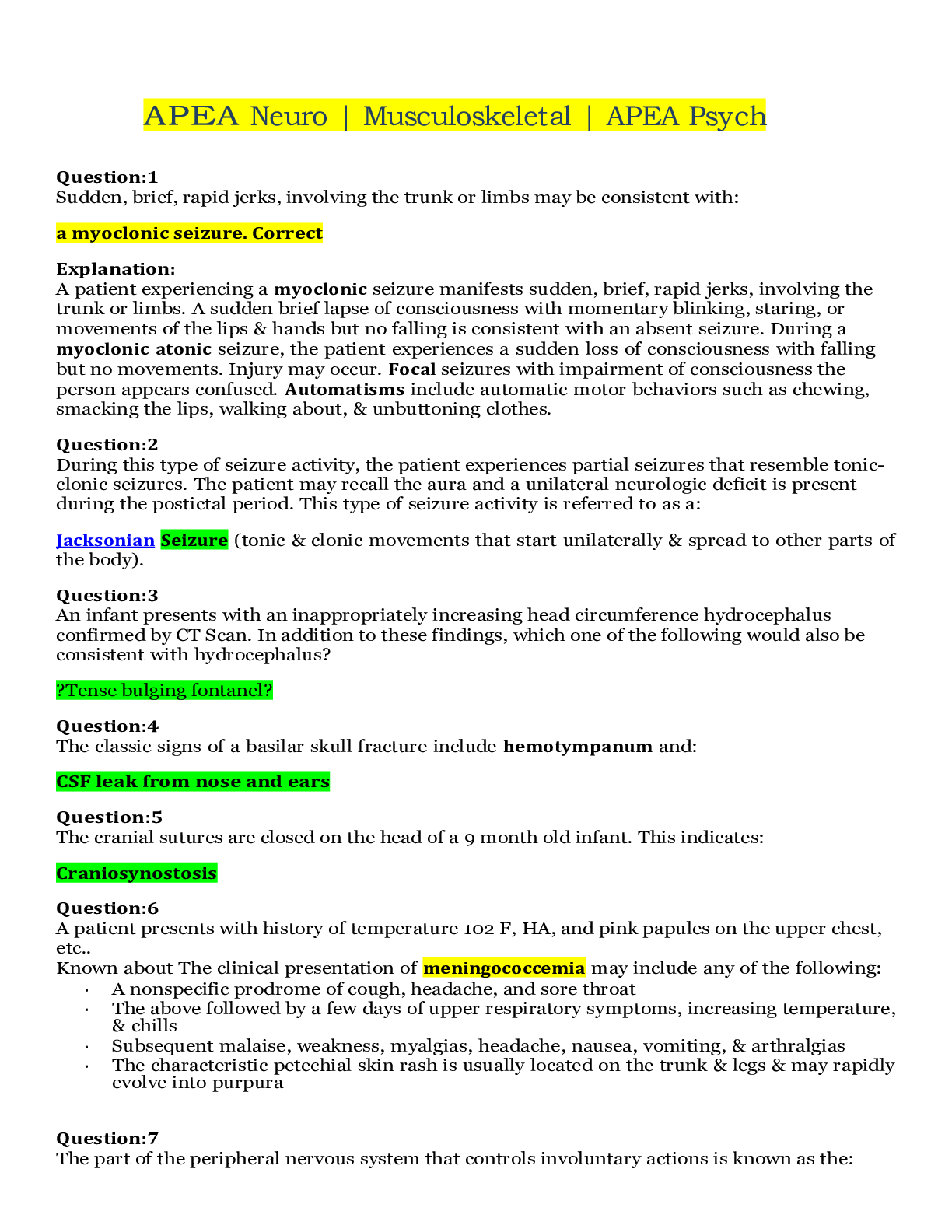


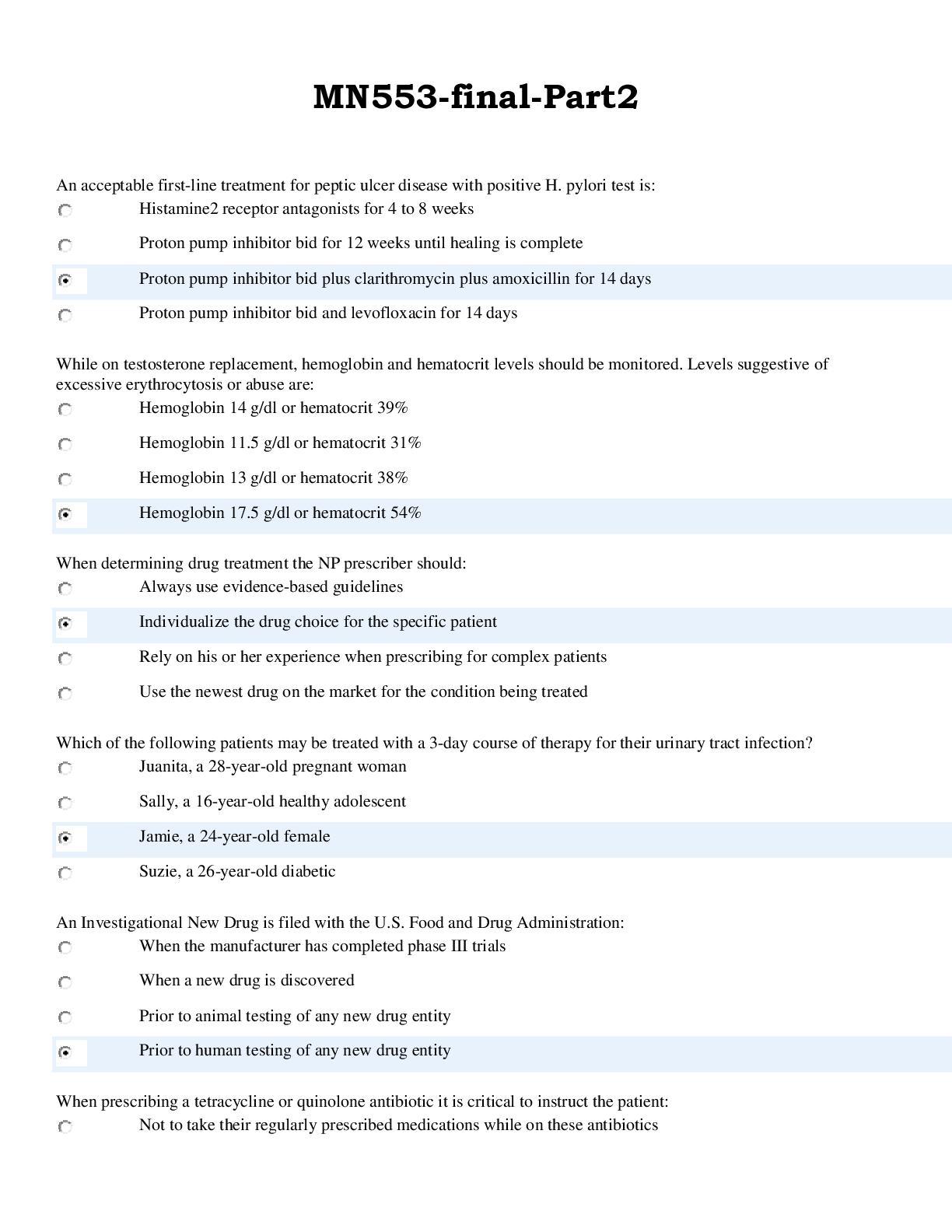
.png)
